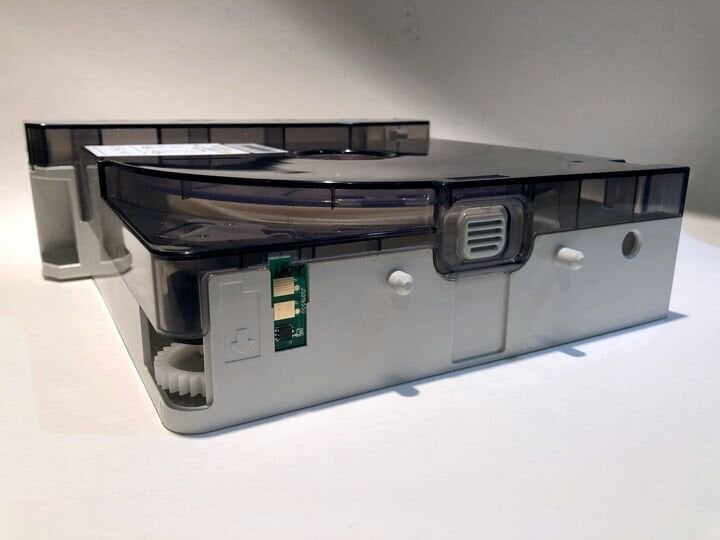![A proprietary cartridge for a 3D printer, showing chip interface [Source: Fabbaloo]](https://fabbaloo.com/wp-content/uploads/2020/05/image-asset_img_5eb050a1c93af.jpg)
There’s been a gradual evolution in how materials are handled in 3D printers.
Today we find there are three — well, perhaps three and a half — approaches for dealing with 3D printer materials, which we list here.
Closed Material 3D Printers
This is the original approach, invented by the founders and original patent holders of the major 3D printing processes. The idea here is the machines are designed to accept only material designed by that manufacturer.
There are some obvious advantages to the manufacturer here, in that they are more-or-less guaranteed a strong revenue flow to accompany each 3D printer sale. In many cases, particularly for larger industrial equipment where devices were leased for many years, this revenue would be significant and perhaps even exceed the value of the machine itself in the long term.
This is usually to the detriment of the 3D printer operator, who is faced with a monopolistic situation when buying materials. In some cases materials are priced far higher than supposedly-equivalent third party materials. However, some forward-thinking 3D printer manufacturers do price their materials quite reasonably.
Another disadvantage to the 3D printer operator is a potential lack of choice of materials. If the machine can accept only materials from the manufacturer, then there is a limited choice. The manufacturers tend to produce only the most widely used materials and often the 3D printer operators feel left out of the ability to use new and exotic materials.
In spite of these disadvantages, there are some advantages for the 3D printer operator, namely that of quality and reliability. If the 3D printer manufacturer knows and controls the precise chemistry of the materials, the print profiles built into the 3D printer’s software can automatically use them and produce high quality output.
Open Material 3D Printers
Open materials machines are quite the opposite. Instead of requiring materials from one source, they accept any material that will physically fit into the machine — obviously resin won’t work in a filament machine, for example, but you get my point.
This offers the advantage to the 3D printer operator of choice: there will be countless sources of materials offering many different materials, and usually at competitive pricing.
However, there is a huge disadvantage: the 3D printer operator may not be aware of the optimum print parameters and may have to undertake considerable experimentation to determine the right way forward.
For some, the price advantage outweighs the likelihood of extra work. But in other cases, particularly when high-priced engineers are at play, it’s the opposite: the cost of experimentation with engineers can exceed the cost of proprietary materials in a closed system.
Hybrid Material 3D Printers
This is the “half” option I mentioned above.
There are several 3D printers now available that offer an interesting feature that allows both open and closed material modes. Two that I know of — and have tried — are Formlabs and Sindoh.
Formlabs began as an open materials company, but shifted towards closed mode when they realized the requirement for quality and speed by their typical clients outweighed the need for lower cost resin. However, they still had clients that required materials they could not provide. Thus they created something called “experimental mode” in which the machine would allow random resins to be used, but in this mode the operator would be wholly responsible for the 3D print parameters.
Similarly, Sindoh began as a closed-material operation, but realized they could not provide the breadth of materials offered by the major chemical companies today. They then created an “open mode” on their 3DWOX 1 device that allows use of any reasonable filament material.
Partnered Material 3D Printers
What seems to be emerging as the target mode for a large number of providers is what I could call “partnered mode”. In this configuration a 3D printer is physically an open materials machine, but it (or its software) is aware of print profiles for a large number of possible materials from third parties.
When materials are loaded and prints prepared, this knowledge is then used to adjust the parameters to achieve correct results automatically.
Pioneers in this field might be Ultimaker, who have partnered with several chemical providers to have a kind of library of print profiles. These are ready on demand when 3D print slicing takes place, and can ensure proper 3D printing.
Other companies are implementing similar protocols. I suspect part of the push behind this is the emergence of major chemical companies who want to be visible, control their branding, and be available to as many 3D printers as possible. The only reasonable way to do that is to provide print profiles to anyone who needs them.
My thought is that this will eventually become the default approach for future 3D printers. However, it’s likely to be improved in some way that is more flexible than today. Today 3D printer manufacturers must specifically make their own arrangements with materials vendors to create and deploy profiles to their users. I hope someone develops a kind of clearing house where these can be centrally maintained and distributed beyond the manufacturers themselves.
One good reason for doing so is that you could lose access to a profile for your expensive device if that manufacturer goes out of business or decides to shut down that profile in their library.
But for now, things have never been better for 3D printing materials.

